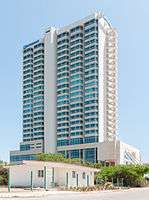Margarita Island
| Native name: <span class="nickname" ">Isla Margarita Nickname: Pearl of the Caribbean | ||||||||||
|---|---|---|---|---|---|---|---|---|---|---|
| ||||||||||
 Margarita | ||||||||||
| Geography | ||||||||||
| Location | Caribbean Sea | |||||||||
| Coordinates | 10°59′13″N 63°56′08″W / 10.98694°N 63.93556°W | |||||||||
| Area | 1,020 km2 (390 sq mi) | |||||||||
| Length | 78 km (48.5 mi) | |||||||||
| Width | 20 km (12 mi) | |||||||||
| Highest elevation | 920 m (3,020 ft) | |||||||||
| Highest point | San Juan or Cerro Grande | |||||||||
| Administration | ||||||||||
|
Venezuela | ||||||||||
| State | Nueva Esparta | |||||||||
| Largest settlement | Porlamar (pop. 85,000) | |||||||||
| Demographics | ||||||||||
| Population | 436,900 | |||||||||
| Pop. density | 411.76 /km2 (1,066.45 /sq mi) | |||||||||
Margarita Island (Isla de Margarita, Spanish pronunciation: [marɣaˈɾita]) is the largest island in the Venezuelan state of Nueva Esparta, situated off the northeastern coast of the country, in the Caribbean Sea. The capital city of Nueva Esparta, La Asunción, is located on the island. Primary industries are tourism, fishing and construction.
History
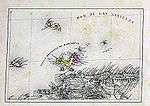
Christopher Columbus was the first European to arrive on Margarita Island in 1498. The local natives were the Guaiqueries people. The coast of the island was abundant in pearls, which represented almost a third of all New World tribute to the Spanish Crown. Margarita Island was fortified against the increasing threat of pirate attacks, and some fortifications remain today. It was the center of Spanish colonial Margarita Province, established in 1525.
In 1561, the island was seized by Lope de Aguirre, a notoriously violent and rebellious conquistador. Around 1675, the island was captured again, this time by Red Legs Greaves, [1] a pirate known for his humanity and morality. He captured a fleet of Spanish ships off port, before turning the guns on the forts which he stormed and claimed a large booty of pearls and gold.
Construction of the fort Santa Rosa was ordered by the governor, Juan Muñoz de Gadea, after the French buccaneer Marquis de Maintenon attacked the island in early 1676.
The island gained independence from the Spanish in 1814 after the collapse of the First Republic of Venezuela. It became the first permanently free territory in Venezuela. In the same year, Luisa Cáceres de Arismendi was detained for over three years in a dungeon of the Fortress of Santa Rosa on the island in an attempt to put pressure on her husband Juan Bautista Arismendi, who was fighting for independence. Simón Bolívar was confirmed as Commander in Chief of the Second Republic of Venezuela on the island in 1816. From there he started a nine-year campaign to free Venezuela, Colombia, Ecuador, Peru, and Bolivia from the Spanish Crown.
Geography
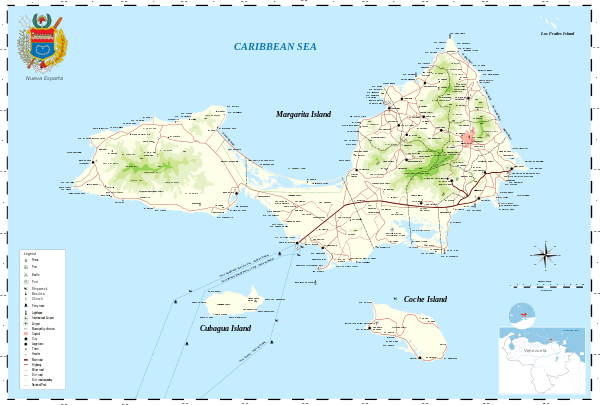
Located in the Caribbean Sea between latitudes 10°52'N and 11°11'N and longitudes 63°48'W and 64°23'W, the island, along with the islands of Coche and Cubagua, comprises the state of Nueva Esparta. The island is split into two peninsulas joined by an 18 kilometres (11 mi) long isthmus and covers an area of 1,020 km². It is 78 kilometres (48 mi) long and measures roughly 20 kilometres (12 mi) at its widest. The climate is sunny and dry with average temperatures ranging from 24 to 37 °C.
Most of the island's 420,000 residents live in the more developed eastern part of the island, which includes the large cities of Porlamar and Pampatar along with the state capital of La Asunción. The island can be reached by direct flights from Caracas or ferries from Puerto La Cruz, Cumaná, and La Guaira. There are no international flights to the island at present.

The Macanao peninsula to the west has a central mountain range in the east-west direction. The highest altitude is 760 metres (2,493 ft) at Pico de Macanao. Several smaller ranges derive from this axis following a north-south orientation with deep valleys between them. The most notable of these valleys is San Francisco in the north-central part of the peninsula. The Paraguachoa peninsula to the East is formed by a mountain range in the north-south direction from Porlamar to Cabo Negro. The highest peaks are San Juan or Cerro Grande at 920 metres (3,018 ft) and El Copey 890 metres (2,920 ft). The peninsulas are connected by the La Restinga isthmus, on which the La Restinga lagoon is located. There are also two breast shaped hills known as Tetas de Maria Guevara on the isthmus.
Terrain
Macanao peninsula consists of mountainous spine of the central west-east, with several culminations, including Macanao Peak, which is the highest, with an altitude of 760 meters above sea level stands. This axial region several side brackets oriented north-south off, including deep valleys are dissected, the most important is San Francisco in the north central of Margarita. The central massif is surrounded by foothills forming a more or less continuous, narrow strip and north and south of the peninsula reaches almost to the coast.[2]
Isla Margarita eastern is formed by a mountain range which runs roughly north-south direction, from northern Porlamar to Cabo Negro; north from the town of El Espinal the massif rises steeply to the culminations of San Juan and Copey hill, showing heights of 960 and 890 m respectively. The hills are Matasite and Guayamurí Los Andes foothills. To the north stands the Tragaplata hill.
Among the higher elevations found on the island, are cited:
|
Paraguachoa:
|
Península de Macanao: |
 Copey Hill - view from San Juan downtown |
Weather
The average temperature is 27 ° C with minimum ranging between 22 ° and 23 ° C and maximum that can easily exceed 34 ° C. Rainfall is common in the winter months or rainy season that begins around July-October (although the rain is usually quite rare). Being located in the Caribbean Sea near the Earth's equator, solar rays fall perpendicularly on the island and therefore it is advisable to always use some sort of sunscreen when visiting its beaches.
Municipalities
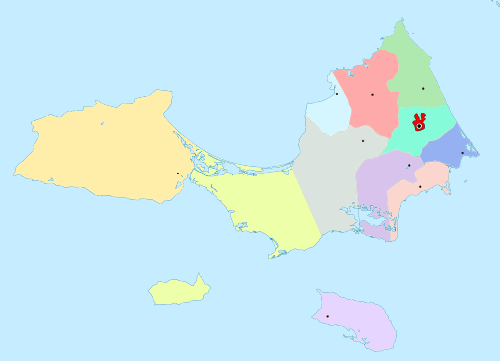
|
|
Cities
La Asunción
La Asunción is the capital of the Federal State of Nueva Esparta with a population of around 28,500. It is the seat of the regional government. The city is overlooked by the Santa Rosa Castle of La Asunción
Pampatar
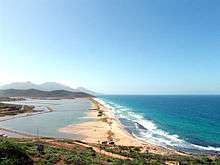
The urban area of Pampatar has a population of around 50,000. A number of the island's larger shopping malls are located in the city, namely Sambil Margarita, Rattan Depot, Centro Comercial La Vela, Centro Comercial Costa Azul, Centro Comercial AB (Avenida Bolivar) and La Redoma. The Royal Fortress of San Carlos Borromeo, constructed in the late 17th century, is located in Pampatar. The city also has several beaches.
Porlamar
The largest city on Margarita Island is Porlamar. The population can reach 125,000 in the high season, while in the low season, the population is about 85,000. Two beaches are located within the city.
Juan Griego
Juan Griego is a city on the northern side of Isla Margarita, and is the most northern port in Venezuela. It has a population of 28,256 inhabitants (as per census of 2001) and is capital of the Marcano municipality of the Nueva Esparta state. Its church of gothic styling, constructed in 1850 by Fray Nicholas de Igualdad, is still, along with the lovely bay, the symbol of the city. The La Galera fortress, where in the early 1820s a fierce battle for independence was fought, is located near the city centre. In 1973, the island become a free port and the city once again become the second city in sequence of importance in the commercial activities after Porlamar.
Tourism
The island's status as a duty-free port and proximity to the mainland make it a popular vacation spot for Venezuelans. It sees a large number of tourists around Christmas time, Easter week, and from July to mid-September. Whiskey, cheese, chocolate, and electrical appliances, among other goods, can be purchased less expensively than on the mainland.
There are at least 50 beaches on the island, which has a 106 miles (171 km) coastline. Playa El Yaque is popular as a windsurfing and kitesurffing location. Playa Parguito, Playa Caribe, Playa Punta Arenas, Playa El Agua and Playa Puerto Cruz are also popular beaches.
Margarita Island was the venue for the 2014 Caribbean Series. It was the second time it hosted the Series; 2010 was the first. It is expected that the development of the tourism industry on the island will be boosted by the influence of predominantly Dominican, Mexican, Puerto Rican, and Venezuelan sports enthusiast who arrived for the competition.
Population
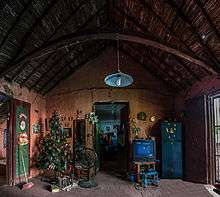
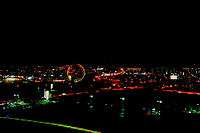
The demonym for islanders is Margariteños/as and Neoespartanos/as. Ethnic minority populations of some significance include Lebanese, Spanish, Italian, German, French, Dutch, Swedish, Norwegian, Danish, Portuguese, Argentine, Chilean, Uruguayan, Colombian, and Chinese. Immigrants from mainland Venezuela are colloquially called navegaos by islanders.
A little less than 25% of the Neoespartanian population live in Porlamar. Margarita's population is just under 440,000, although this tends to fluctuate during holiday periods and the festive season.
Religion
The predominant religion is Roman Catholicism. Other Christian denominations are also present. Of the churches that present in the Neospartan entity, among the most important are: Basílica de la Virgen del Valle (in the Valley of the Espíritu Santo), Cathedral of La Asunción, Iglesia San Juan Evangelista (Juangriego), Iglesia parroquial de San Juan (San Juan Bautista), Iglesia de San Nicolás de Bari (Porlamar), of the San José de Paraguachi and other churches and chapels minor located in populations of Santa Ana, Punta de Piedras, Porlamar, Pampatar and virtually all the towns of the island. There are also small populations of Jews and Muslims.
Evangelical Christian churches have had a significant growth in recent years demonstrating their presence and impact in the population of the island. One of the fastest-growing is the Centro Cristiano Casa de Alabanza (CCCA), present in Porlamar, Juan Griego, La Asunción and Tubores Municipality.
The patron saint of eastern Venezuela is the Virgen del Valle and in the population El Valle del Espíritu Santo is the Basílica Menor de Nuestra Señora del Valle, which approaching Margarita, Coche and Cubagua Islanders visit to honor her on her feast day.
Natural Heritage
Las Tetas de María Guevara (Maria Guevara's breasts)
The Las Tetas de Maria Guevara, located in a coastal plain in the south of the 1,670 hectare Laguna de La Restinga National Park, consists of two small twin hills with a height of 135 metres (443 ft). The vegetation around the hills is desert, with cacti, prickly pears, yaks, guamaches. The fauna is diverse, including desert lizards, rabbits, rattlesnakes and coral.
The legend told by the inhabitants of the island goes that the name María Guevara comes from a white young girl who was heavily involved in the War of Independence and that upon her death, the hills rose on her grave. One other Margaritan myth says the source of the name also comes from the same woman, but that she was from Cumaná and came to the island to lead a group of men in fishing activities. As she had small breasts, by way of derision whenever they sighted the hills said, "there are the lady's tits" and the name was created. The area was declared a national park on February 27, 1974.
Crime
On 7 February 2014, a German tourist Horst Kurt Fritz was killed by two gunmen on a stolen motorcycle a few hours of arriving on the island, at a local craft Margaritenãs located around SAMBIL mall. The sexagenarian, belonged to a group of tourists who had arrived on a cruise ship to visit the island.[3]
On 3 September 2013, a Dutch sailor was killed on his yacht while resisting armed robbers attempting to board his boat.[4]
On 20 January 2012, about 30 or 35 Brazilian tourists were robbed in their hotel in Antolin del Campo, Margarita, by a gang of between 13 and 15 armed robbers.[5]
Starting in October 2011, the Government installed equipment that requires everyone visiting Margarita Island to electronically register their fingerprints and a picture when entering Margarita Island.[6]
Since 2010, there have been numerous instances of tourist murders. On 27 August 2010 an Italian tourist, Emiliano Astore, was murdered on his boat anchored off Margarita Island in an apparent robbery. Two police officers and a civilian were arrested. A third officer was implicated in the "exploitation of objects" from the crime.[7] On 18 July 2011, 28-year-old Briton Tom Ossel was killed resisting seven armed robbers who had tricked their way into the backpackers hotel before they took the guests hostage and raiding rooms for valuables.[8] On 29 March 2011, French tourist Francés Yves Le Bras was murdered in a robbery at the Laguna Mar hotel while he and his wife dined at the Guacuco restaurant.[9] In March 2011, Belgian tourist Bonne Philippe was murdered while eating in a fast food outlet in Playa El Agua, Margarita.[10]
The US Government has not issued any warnings of violent crime on Margarita Island, but there is a warning for all of Venezuela.[11] The UK Foreign and Commonwealth Office warns that street crime in mainland Venezuela is high, and that armed muggings and 'express kidnappings' – opportunistic abductions to extort money from someone - are regular occurrences.[12]
Since 1998, there have been about ten pirate attacks on or near Margarita Island. Venezuela is now listed as a dangerous region for pirate attacks and in many regions, including between Margarita and Sucre, sailors should not anchor and yachts should sail in company.[13][14]
See also
References
- ↑ Red Legs Greaves Pirates of the Caribbean.
- ↑ Physical Characteristics of Isla Margarita (spanish)
- ↑ Hubo 4.680 homicidios en los primeros cuatro meses del año
- ↑ "Venezuela, Isla Margarita: Dutch sailor killed whilst resisting robbery on board - September 2013".
- ↑ "Asaltan a 30 turistas brasileños en isla Margarita". El Mundo. Retrieved 3 March 2012.
- ↑ "Travelers to the Island of Margarita".
- ↑ "Two Cops Arrested for Murder of Italian in Venezuela". Latin American Herald Tribune. Retrieved 3 March 2012.
- ↑ "Suspect wanted for killing Briton 'was just out of jail'". London Evening Standard.
- ↑ ANA CAROLINA ARIAS (31 March 2011). "Buscan a asesino de turista en todo el oriente del país". EL UNIVERSAL. Retrieved 3 March 2012.
- ↑ "French tourist mugged and murdered at a hotel in Margarita, Venezuela". entornointeligente.com. 30 March 2011. Retrieved 3 March 2012.
- ↑ "Venezuela travel warning". U.S. Department of State. 7 July 2016.
- ↑ Andrew Levy (20 Jul 2011). "Hero British firefighter, 28, died saving his brother from holiday robbers". The Daily Mail. Retrieved 3 March 2012.
- ↑ Klaus Hympendahl. "Yacht Piracy, Information centre for bluewater sailors". Klaus Hympendahl. Retrieved 3 March 2012.
- ↑ Klaus Hympendahl (2010). "Registration of pirate attacks since 1996". Klaus Hympendahl. Retrieved 3 March 2012.
External links
| Wikimedia Commons has media related to Isla Margarita. |
 Margarita Island travel guide from Wikivoyage
Margarita Island travel guide from Wikivoyage- (Spanish) Nuevaesparta.gob.ve: Official Isla de Margarita government website

Coordinates: 10°59′13″N 63°56′08″W / 10.98694°N 63.93556°W
.jpg)


